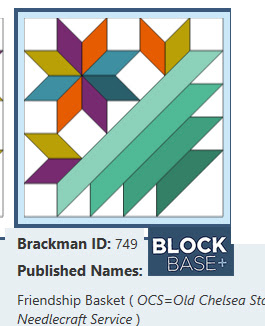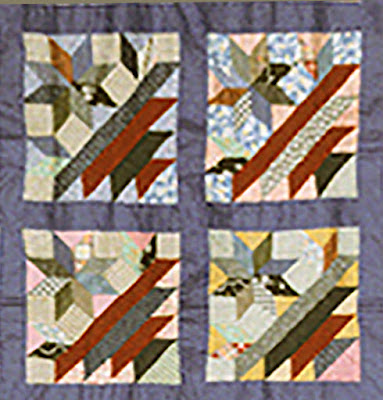Collection Illinois State Museum
What's It All Mean?
We often speculate about symbolism and meaning in antique quilt patterns---usually to no avail although people do love to make up stories. Fraternal imagery like that in this mid-20th-century applique made by The Daughters of Rebekah group in Temple Hill, Illinois, however, is one category where mysterious images do carry meaning we can accurately interpret. The Daughters of Rebekah organization is the women's branch of the International Order of Odd Fellows (IOOF---above with a bit of dyslexia.)
New Jersey man decked out with fraternal imagery,
secret and not so-secret symbols designed to build fellowship and
identify lodge brothers.
Quilt perhaps 1880-1920, attributed to Clydie Alcorn Benson in Nova Scotia
by the Rhode Island project. Photo from the Quilt Index.
The Masons, Freemasons or Scottish Rite associations were the largest fraternal organization in the 19th-century and their symbol of compass and carpenter's square ruler is quite familiar.
Sampler dated 1867 associated with Annie Jackson
Apparently no one is telling us outsiders what that G means,
although speculation says Geometry or God.
Quilt from "Columbia Lodg No 44 Oh, 1867".
Collection of the Milwaukee Museum
Many of us are familiar with the Masons as a local, rather old-fashioned, benevolent social group with an often distinguished lodge hall.
Big building, small town Kansas
But the Masons have not always been viewed as a community asset. About 200 years ago the secret society was the target of paranoid hatred that resulted in a political party flourishing on conspiracy theories.
National Heritage Museum,
Masonic Handkerchief Medallion, ca. 1817, probably New England
The National Heritage Museum in Massachusetts collects and shows material culture from the Masons. Curator Aimee Newell discussed this quilt, the earliest with recognizable Masonic imagery, here:
She dates the central handkerchief, a lexicon of their symbols, to 1814.
The Masons were an 18th-century British fraternity with the first colonial branch established in Boston in 1733. Ambitious and aristocratic American men joined.
Benjamin Franklin in a Masonic
apron, ceremonial clothing
Revolutionaries Benjamin Franklin, George Washington, Paul Revere and John Hancock were Masons. But forty years after the Revolution some in Young America began viewing the clandestine group as elite power brokers plotting against rural concepts of American values.
The Burned Over District with Rochester in Monroe County under the arrow
Proclaiming their main point in their name, the Anti-Masonic party prospered in the 1825-1845 period. The party base was western New York, the area known as the Burned Over District due to political and religious fevers that flamed through the region. Believers in unorthodox novel Protestantism, called the Second Great Awakening, feared Enlightenment ideas of theology associated with the Masons. Religion combined with anti-Andrew-Jackson politics (President 1829-1837) plus xenophobia towards outsiders settling there (native New Englanders moving west.) Trends led to paranoid conspiracy theories that attracted many rural working class and conservative yeoman farmers.
Morgan slain
In the mid 1820s William Morgan, claiming to be a disaffected Mason, began revealing secrets in Batavia, New York southwest of Rochester. He was said to have been kidnapped by Masons and drowned in 1826, generating trials with no convictions and an overreaction that eventually led to a viable third-party that elected two governors and many demagogues looking to appeal to the base.
Library of Congress
A negative view of the new third party
Early Anti-Masons’ theories wove a fabric of loose threads such as distrust of lawyers, politicians and educated elites with fears of the fraternity’s supposed anti-Christian dogma, its international plots aiming to reunite the U.S. with Great Britain and general opposition to the Jackson administration.
Jackson and the Pope?
An Anti-Masonic View of a very doubtful partnership
“The anti-Masonic movement was a product not merely of natural enthusiasm but also of the vicissitudes of party politics. It was joined and used by a great many men who did not fully share its original anti-Masonic feelings. It attracted the support of several reputable statemen who had only mild sympathy with its fundamental bias, but who as politicians could not afford to ignore it.” Richard J. Hofstadter, 1964.
Greeley and his HG campaign fabric 1872
He lost to incumbent U.S. Grant
Future Democratic Presidential candidate, young New Yorker Horace Greeley (1811-1872 ) recalled being a “devoted Anti-Mason,” although he acknowledged the movement supported “unprincipled demagogues.” Radical sentiments coalesced into a viable third party with the first political convention held in 1831, definitely opposed to the secret society.

Opposition view of that first party convention in Baltimore (Valdimor)
Anti-Masonic plank in the platform:
“The Lodge is an enemy of the home. How often a Mason spends $3OO for his uniform, while his wife wears a $1.50 calico dress.”
Free Library of Philadelphia Collection
Anti-Masonic mania died out in the mid- to late-1830s as the Whig party developed more practical principles based on opposition to Jackson. Many Anti-Masonic politicians became Whigs.
Katcher Collection
Pro-Harrison, pro-Whig block from a Baltimore album
quilt associated with Sarah Mary Poole
William Henry Harrison, elected President as a Whig in 1840, had been considered for the Anti-Masonic nomination four years earlier.
Portraits of Andrew Jackson and fellow Democrat Martin Van Buren
in the home of a hungry family in 1837
Grassroots concerns became focused on real threats as the widespread Panic of 1837 threw a third of New Yorkers out of work and reduced wages for those who were still employed by a third to a half.
“1833-1843 witnessed the rapid decline….In New York, the cradle of Antimasonry, [Thurlow] Weed and his circle could hardly wait for the dust to settle on the 1832 election before [forming] the Whig Party….Antimasonry was a little more than memory by 1837.” William Preston Vaughn, The Anti-Masonic Party in the United States: 1826-1843, 2014.
Like later political movements based on conspiracies and hatred, Anti-Masonry burnt out. Consider the Know Nothing party of the 1850s, the Joseph McCarthy anti-communist campaign of the 1950s.
As one can imagine, Masons suffered much from the hate of the 1825-1840 years, losing many members and lodges. Once conspiracy theories were forgotten they enjoyed a revival, which we see reflected in the Masonic quilts of the 1840s and beyond.
Border corner in a four-block quilt, last half 19th-c.
National Museum of American History
Appliqued sampler by Susan Rogers, dated 1867, Brooklyn, New York
Why are so many of these dated right after the Civil War, 1867-1868?
My guess is that the Order of the Eastern Star welcoming women as well as men to Masonic society, which was founded in 1850, underwent expansion under new leadership in 1866. An area for further research....
Quilt dated 1868, attributed to Spiritualist Community in
Willimantic, Connecticut with Jumbo the elephant
and a Masonic compass among other symbols.
Why paranoia becomes politics is a more mysterious question. Historian Richard Hofstadter looked at Anti-Masonry's transition from one held by “certifiable lunatics” to “more or less normal people,” in his 1964 essay:
“I have neither the competence nor the desire to classify any figures of the past or present as certifiable lunatics. In fact, the idea of the paranoid style as a force in politics would have little contemporary relevance or historical value if it were applied only to men with profoundly disturbed minds. It is the use of paranoid modes of expression by more or less normal people that makes the phenomenon significant.”
National Heritage Museum, Sampler attributed to
Jane Haight Webster (1808-1877)
Further Reading
New England quilt museum curator Pam Weeks has a Pinterest Page on Masonic Symbols in Quilts:














4OBCKg~~0_3.jpg)



















.jpg)

.jpg)


















